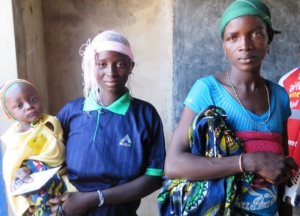USAID Programs in Burkina Faso
 Burkina Faso is one of the world’s poorest countries. The World Food Programme (WFP) estimates that over four in 10 Burkinabè live in poverty. A high dependency on agriculture, as well as natural disasters, political instability and armed domestic conflict have increased food instability and displaced millions of people in the country. USAID programs in Burkina Faso work to improve the lives of the population. The agency’s work in Burkina Faso is extensive, covering many areas.
Burkina Faso is one of the world’s poorest countries. The World Food Programme (WFP) estimates that over four in 10 Burkinabè live in poverty. A high dependency on agriculture, as well as natural disasters, political instability and armed domestic conflict have increased food instability and displaced millions of people in the country. USAID programs in Burkina Faso work to improve the lives of the population. The agency’s work in Burkina Faso is extensive, covering many areas.
Agriculture and Food Security
Agriculture plays a massive role in the Burkinabè economy, with the sector being responsible for the income of 80% of the population. Despite this, food insecurity is high. The WFP estimates that over 3 million people face acute food insecurity, which is why USAID programs in the country work to improve agriculture production and access to food in the country.
In the fiscal year 2021, USAID provided over $11 million for agriculture and food security programs in Burkina Faso. Regarding agriculture, one of the areas of focus for USAID programs is increasing the production of food by educating farmers on better agricultural practices. In addition, by strengthening the stability of markets and providing microloans, the U.S. helps Burkinabè farmers have more stable, financially viable agriculture businesses.
Due to the high levels of food insecurity, USAID programs in Burkina Faso addressing this issue are essential. By way of USAID’s Office of Food for Peace (FFP), the agency works with the World Food Programme to donate food to hundreds of thousands of people. FFP also partners with other agencies working in the country. For example, in 2018, together with ACDI/VOCA, FFP pledged $50 million in food assistance and resilience building for particularly vulnerable families in Burkina Faso’s Centre-North region.
Democracy and Human Rights
Burkina Faso saw the democratically elected leader of the country ousted in 2022, in a blow to the country’s democratic transition. USAID programs in Burkina Faso remain committed to supporting democracy — for example, through the training of independent election officials and organizing conferences on democratic governance.
USAID programs in Burkina Faso also support those institutions in the country that monitor human rights violations and ensure victims of human rights violations are able to access justice.
Health
Like many impoverished countries, Burkina Faso faces a number of challenges in the health sector, so USAID programs in Burkina Faso that work towards improving the health of the population are of high importance.
The main health issue concerning Burkina Faso is the prevalence of malaria. The disease, which has been eradicated in many wealthy countries, is the main cause of death for children under the age of 5 in the country, according to UNICEF, and USAID reports that nearly 20,000 people were killed by malaria in Burkina Faso in 2020 alone. This number can be seen as the reason why USAID provided $128.5 million for the fight against malaria in Burkina Faso between 2017 and 2022. Malaria prevention infrastructure, diagnostic tests and medication are all funded by USAID programs in Burkina Faso, highlighting the broad approach aid is taking to fight the disease. For the future, a new, effective Malaria vaccine looks promising, and USAID programs are likely to fund vaccine distributions should a vaccine become broadly usable.
While malaria may be the main health issue facing Burkina Faso, the country also requires support in fighting HIV/AIDS. Regarding this illness, international efforts including those of USAID appear to be bearing fruit as the number of HIV/AIDS-related deaths has steadily declined since the early 1990s.
Humanitarian Assistance
A significant portion of USAID programs in Burkina Faso is focused on the provision of humanitarian assistance. The country has seen multiple humanitarian crises in the past years, due to crop failures, domestic armed conflict and natural disasters. As a consequence of these crises, the Internal Displacement Monitoring Centre estimates that as of 2022, around 2.2 million people were internally displaced in Burkina Faso. By way of its Bureau of Humanitarian Assistance, USAID provided $54.4 million in humanitarian aid to the country in the fiscal year 2021 alone.
Water and Sanitation
UNICEF estimates that in 2021, 2.4 million people in Burkina Faso lacked access to safe water. This is why USAID programs in Burkina Faso improving the water and sanitation circumstances have a high priority. Within this area, USAID has a broad field of programs to improve the lives of Burkinabè. Concrete actions by USAID include the improvement and establishment of water points, the monitoring of groundwater and water systems infrastructure as well as the provision of tools and education enabling communities and health care providers to access safer water.
Looking Ahead
The challenges faced by Burkina Faso are great, and poverty remains widespread in the country. USAID programs in Burkina Faso will need to continue providing support for the foreseeable future if the lives of Burkinabè are to be improved. The announcement of additional aid by the U.S. in the last two years to West Africa may be a sign that USAID will further expand its programs in the country and spells hope for those in need in Burkina Faso.
– Patrick Brownlow
Photo: Flickr
